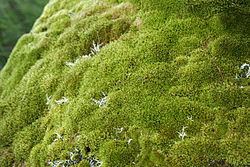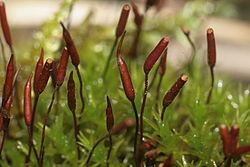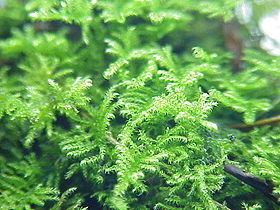Scientific name Bryopsida Rank Class | Division Bryophyta Higher classification Moss | |
 | ||
Lower classifications Bryidae, Fissidens, Hylocomiaceae | ||
Fsc biology book1 ch 9 lec 6 classification of bryophytes bryopsida
The Bryopsida constitute the largest class of mosses, containing 95% of all moss species. It consists of approximately 11,500 species, common throughout the whole world.
Contents
- Fsc biology book1 ch 9 lec 6 classification of bryophytes bryopsida
- Fsc biology book1 ch 9 lec 6 classification of bryophytes bryopsida maktab pk
- Capsule structure
- Classification
- Phylogeny
- References

The group is distinguished by having spore capsules with teeth that are arthrodontous; the teeth are separate from each other and jointed at the base where they attach to the opening of the capsule. These teeth are exposed when the covering operculum falls off. In other groups of mosses, the capsule is either nematodontous with an attached operculum, or else splits open without operculum or teeth.

Fsc biology book1 ch 9 lec 6 classification of bryophytes bryopsida maktab pk
Capsule structure

Among the Bryopsida, the structure of the capsule (sporangium) and its pattern of development is very useful both for classifying and for identifying moss families. Most Bryopsida produce a capsule with a lid (the operculum) which falls off when the spores inside are mature and thus ready to be dispersed. The opening thus revealed is called the stoma (meaning "mouth") and is surrounded by one or two peristomes. A peristome is a ring of triangular "teeth" formed from the remnants of specially thickened cell walls. There are usually 16 such teeth in a single peristome, and in the Bryopsida the teeth are separate from each other and able to both fold in to cover the stoma as well as fold back to open the stoma. This articulation of the teeth is termed arthrodontous.

There are two basic arthrodontous peristome types. The first type is termed haplolepidous and consists of a single circle of 16 peristome teeth. This type of peristome is characteristic of subclass Dicranidae. The second type is the diplolepidous peristome found in subclasses Bryidae, Funariidae, and Timmiidae. In this type, there are two rings of peristome teeth—an inner endostome (short for endoperistome) and an exostome. The endostome is a more delicate membrane, and its teeth are aligned between the teeth of the exostome. There are a few mosses in the Bryopsida that have no peristome in their capsules. These mosses still undergo the same cell division patterns in capsule development, but the teeth do not fully develop.
Classification
In the past, the group Bryopsida included all mosses. Current circumscriptions of the group are more limited.
Phylogeny
A detailed phylogeny to the level of order, based on the work by Novíkov & Barabaš-Krasni 2015.

